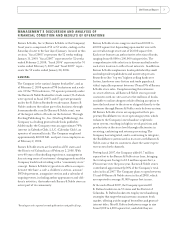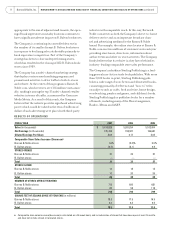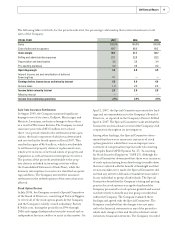Barnes and Noble 2007 Annual Report Download - page 18
Download and view the complete annual report
Please find page 18 of the 2007 Barnes and Noble annual report below. You can navigate through the pages in the report by either clicking on the pages listed below, or by using the keyword search tool below to find specific information within the annual report.
Stock-Based Compensation
Eff ective January 29, 2006, the Company adopted the
provisions of SFAS 123R, using the modifi
ed prospective
transition method. Under this transition method, stock-
based compensation expense recognized for share-based
awards during fi
scal 2006 includes (a) compensation
expense for all stock-based compensation awards granted
prior to, but not yet vested as of, January 29, 2006, based
on the grant date fair value estimated in accordance with
the original provisions of SFAS 123, revised to estimate
forfeitures, and (b) compensation expense for all stock-
based compensation awards granted subsequent to January
29, 2006, based on the grant date fair value estimated in
accordance with the provisions of SFAS 123R. In accor-
dance with the modifi
ed prospective transition method,
results for fi
scal 2005 have not been restated. Prior to the
adoption of SFAS 123R, the Company recognized stock-
based compensation expense in accordance with APB 25
and related Interpretations, as permitted by SFAS 123.
The calculation of share-based employee compensation
expense involves estimates that require management’s
judgment. These estimates include the fair value of
each of the stock option awards granted, which is
estimated on the date of grant using a Black-Scholes
option pricing model. There are two signifi cant inputs
into the Black-Scholes option pricing model: expected
volatility and expected term. The Company estimates
expected volatility based on traded option volatility of
the Company’s stock over a term equal to the expected
term of the option granted. The expected term of stock
option awards granted is derived from historical exercise
experience under the Company’s stock option plans and
represents the period of time that stock option awards
granted are expected to be outstanding. The assumptions
used in calculating the fair value of share-based payment
awards represent management’s best estimates, but these
estimates involve inherent uncertainties and the applica-
tion of management’s judgment. As a result, if factors
change and the Company uses diff
erent assumptions,
stock-based compensation expense could be materi-
ally diff
erent in the future. In addition, the Company is
required to estimate the expected forfeiture rate, and
only recognize expense for those shares expected to vest.
If the Company’s actual forfeiture rate is materially dif-
ferent from its estimate, the stock-based compensation
expense could be signifi
cantly diff
erent from what the
Company has recorded in the current period. See Note
3 to the Consolidated Financial Statements for a further
discussion on stock-based compensation.
Other Long-Lived Assets
The Company’s other long-lived assets include property
and equipment and amortizable intangibles. At February
2, 2008, the Company had $824.6 million of property
and equipment, net of accumulated depreciation, and
$18.1 million of amortizable intangible assets, net of
amortization, accounting for approximately 25.9% of the
Company’s total assets. The Company reviews its long-
lived assets for impairment whenever events or changes
in circumstances indicate that the carrying amount of an
asset may not be recoverable in accordance with SFAS
No. 144, “Accounting for the Impairment or Disposal
of Long-Lived Assets.” The Company evaluates long-
lived assets for impairment at the individual store level,
which is the lowest level at which individual cash fl
ows
can be identifi
ed. When evaluating long-lived assets for
potential impairment, the Company will fi
rst compare
the carrying amount of the assets to the individual
store’s estimated future undiscounted cash fl
ows. If the
estimated future cash fl
ows are less than the carrying
amount of the assets, an impairment loss calculation is
prepared. The impairment loss calculation compares
the carrying amount of the assets to the individual
store’s fair value based on its estimated discounted
future cash fl
ows. If required, an impairment loss is
recorded for that portion of the asset’s carrying value
in excess of fair value. Impairment losses included in
selling and administrative expenses totaled $5.9 million,
$3.4 million and $12.7 million in fi
scal 2007, 2006 and
2005, respectively and are related to individual store
locations.
Goodwill and Unamortizable Intangible Assets
At February 2, 2008, the Company had $255.3 million of
goodwill and $69.9 million of unamortizable intangible
assets (those with an indefi
nite useful life), account-
ing for approximately 10.0% of the Company’s total
assets. SFAS No. 142, “Goodwill and Other Intangible
Assets,” requires that goodwill and other unamortizable
intangible assets no longer be amortized, but instead be
tested for impairment at least annually or earlier if there
are impairment indicators. The Company performs a
two-step process for impairment testing of goodwill
as required by SFAS No. 142. The fi rst step of this test,
used to identify potential impairment, compares the
estimated fair value of a reporting unit with its carrying
amount. The second step (if necessary) measures the
amount of the impairment. The Company completed its
annual impairment test on the goodwill in November
16 Barnes & Noble, Inc. MANAGEMENT’S DISCUSSION AND ANALYSIS OF FINANCIAL CONDITION AND RESULTS OF OPERATIONS continued
























